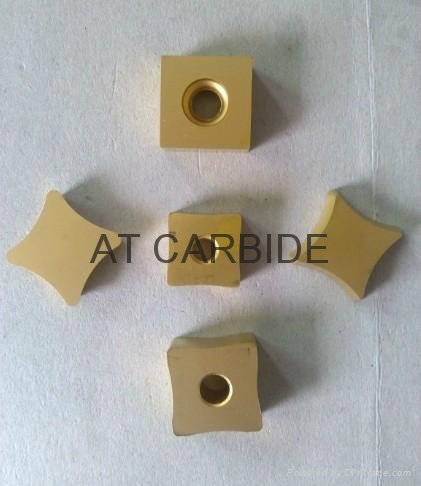You know those little ceramic inserts used for scarfing the OD upset seam of tube after its welded, why don’t they last? Why do they break after only a short time in use?
It may seem an insignificant little tool at first, but if you look at the life expectancy of your scarfing tool you’ll be able to clearly see how all tools and equipment are cared for in a tube manufacturing shop. The attitude, pride, determination, and resourcefulness of a company will come to the fore. Long scarf tool life is directly related to maintenance, tool setup, slitting practices, and attention to detail. Long scarfing tool life can be equated with a successful welding operation.
Nearly every welded tube mill will use a scarfing tool to remove the OD weld bead created by forge-welding (deburring). Removing the bead leaves a perfectly smooth surface; the weld zone should be visually indistinguishable.
The primary reason scarfing tools break is a direct result of temperature change. When weld power is shut off weld seam and scarf strand temperatures drop. This leads to increase in bead strength increased load on the scarfing tool, and breakage. But there are things that can be done to extend tool life.
Scarfing tools fail as a result of poor manufacturing quality control. If materials do not meet spec or improper coating and grinding processes are followed, scarfing tools will fail. Poor controls result in a lack of uniformity in tool performance. Variation in incoming strip material quality will vary the work load conditions. This will lead to damage in the weakest link, the insert. Additionally, Inserts should be purchased based on performance, rather than cost.
Poor shipping and handling practices - that result in impact - lead to flaking and crazing of the cutting surface. These imperfections lead to failure. Remember inserts are hard, but they are also very brittle. They should not be thrown in a junk drawer.
Improper application will shorten the life of scarfing tools. Don’t use a holder that doesn’t match the relief angle or use an insert that has a radius too small for the tube being scarfed. Improper mounting or application of the tool can cause failure.
Sloppy housekeeping and not cleaning off mounting surfaces before installing new inserts is a carless mistake as well. Properly designed and maintained scarf stations extend tool life.
Failure to raise the scarfing tool when an ends weld passes or when the line stops may lead to a shattered insert. Follow the end weld through the line.
These tips from the Kent Corporation are sure to benefit you in your process improvement and extend the life of your tools.
How to get the most out of your OD scarfing tool or OD scarfing ring
1.OD Scarfing Tool and OD scarfing ring Rules of Thumb:
1. When OD tube scarfing, it is best to scarf the unwanted weld bead from the tube as close to the weld zone as possible. The hotter the weld bead, the easier it is for the OD scarfing tool to cut.
2. When placing your scarfing tool closer to the weld zone, the least load is applied to the scarfing tool and scarfing tool holder. This will allow the OD scarfing tool or OD scarfing ring to provide you with a smoother and more desirable finish.
2.If you experience premature OD scarfing tool wear and poor tube scarfing quality:
1. Are you using the scarfing tool holder closest to the weld squeeze point?
2. If you are OD scarfing small diameter tube, are you supporting the tube with a support pad?
3. If you are OD scarfing large diameter tube, it is best to use support rollers to support the tube.
Check out the following tips on reducing weld chatter to improve the quality of your end product
1.Weld Chatter in tube scarfing applications:
Weld chatter is the result of not being able to scarf the weld bead properly enough to achieve a good, clean tube. The OD scarfing tool “chatters” and produces a finish that appears “ribbed” on the OD of the tube. Here are some tips for reducing weld chatter.
1. The OD scarfing tool or OD scarfing ring should have a slightly larger radius than the OD of the tube.
2. An “ironing pass” can be used after the scarf stand. This stand “irons” out any imperfections the OD scarfing tool misses.
3. On mills with induction welding, reposition the induction coil away from the weld rolls to help temper the edges of the strip by preheating them before welding. The resulting material is softer and thus easier for the OD scarfing tool to cut.
4. The scarfing tool relief should be set at an angle of at least 11 degrees from the work piece. This prevents the OD scarfing tool or OD scarfing ring from dragging on the tube.
2.Weld Chatter: Other causes
1. Not enough weld bead for the scarfing tool to cut.
2. Not enough weld power to forge the weld properly.
3. The OD scarfing tool stand is located too far from the weld box causing the weld bead to cool down and not be cut smoothly.
4. The tube is jumping at the scarf point because there is no support plate or support roll under the scarfing tool.
5. Incorrect OD scarfing tool radius.
6. Dull, chipped, or worn scarfing tool.
Link:
http://www.weldmyworld.com/blog/2011/01/reasons-scarfing-tools-fail-1.html